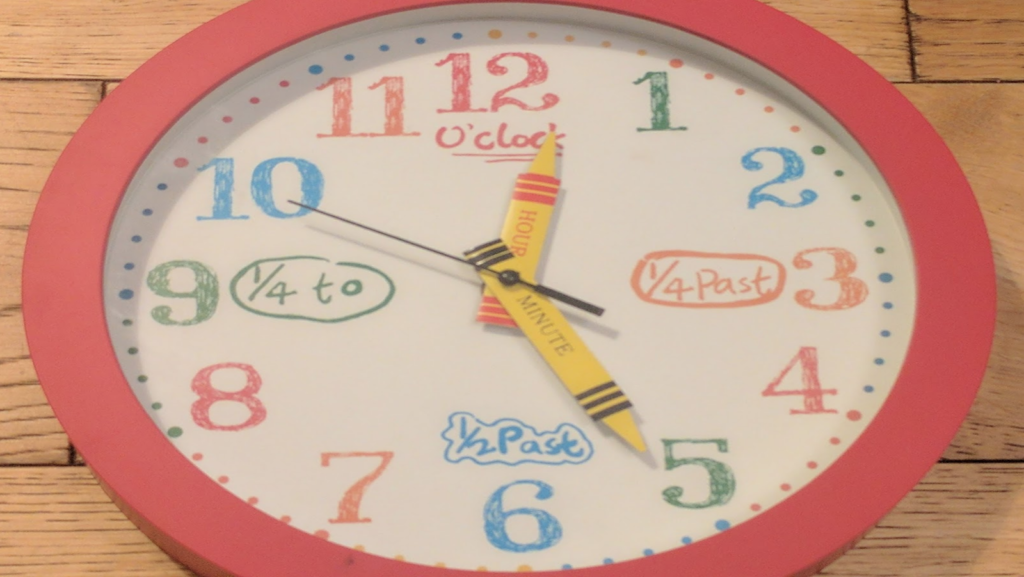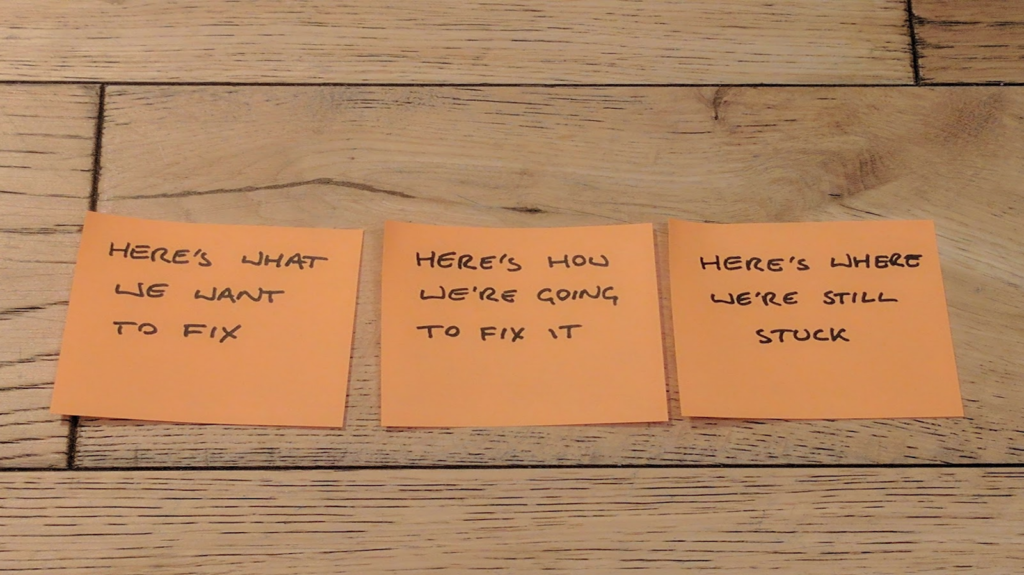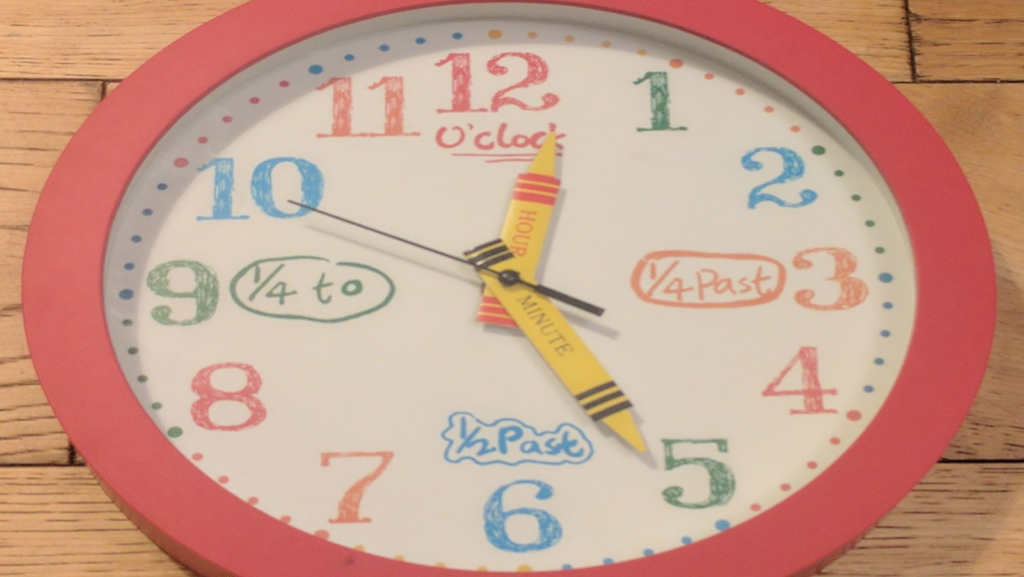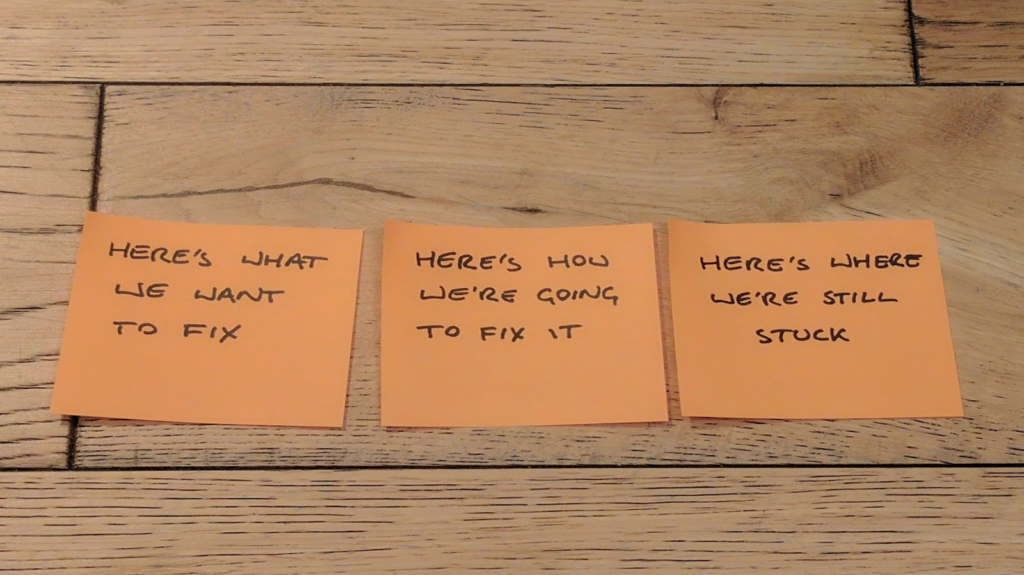This is a multipart series.
- This post: an overview of a workshop
- Part 2: the kinds of disappointment I mean
- Part 3: some tools I’ve found useful.
This series of posts describes a workshop I’ve run a few times, both inside my workplaces and at external events. I’ve found it a useful way to share some things I’ve learned and things I’m still struggling with, and to get participants to share ideas from their own experience.
The posts should give you all you need to try out running the workshop at your own workplace — this might be a good way for your team or organisation to talk about things you’d like to tackle, and ways you could start working on them.
What this workshop’s all about

The slides are all available online at https://speakerdeck.com/neilvass/how-to-disappoint-people, along with a synopsis:
Many projects start with grand ambitions and limited time and money — some kind of disappointment is inevitable. There are different approaches we can take to disappointing people, some of which lead to projects being seen as successes and others which end in tears and recriminations.
In this workshop I’ll tour through some recurring sources of disappointment I’ve seen and techniques for coming to terms with them, before giving participants a chance to work through some ideas from their own experience.
For more details, ask me on Twitter: @neil_vass
Structure of the workshop
Feel free to change this as much as you like — here’s a structure that’s worked for me.
I’ve generally run this as a 90-minute session, with groups of up to 40. The room should have tables with post-its, pens and some large sheets of paper for presentations/notes. Ideally you’d want 4 to 6 people at each table.
I start with an introduction to the types of disappointment I mean — this is about a 10-minute tour, described in part 2 of this post series.
Then, it’s over to the participants (artist’s impression):

Ask everyone to think about their overall reaction to hearing the types of disappointment they’ve just toured through.

Instructions for the room:
Could you pick which of these categories best describes your reaction to that introduction? Choose the best fit and write it on an index card.
- “I know just what you mean” — this is describing your problems exactly, it’s just like Killing Me Softly.
- “I don’t recognize any of these problems” — these just don’t ring true to you, you’ve never really come across any of them and can’t believe people behave that way.
- “I have great examples you’ve never thought of” — you may or may not recognize a lot of what’s going on in my examples, but I’m missing some really common/interesting/important ones.
- “I have the answers” — if you know these exact problems but you’re confident you know what to do about all of them, this one’s you.
I thought about:
- everyone with the same number — so we’ll get one presentation of people new to this, one from veterans, etc.
- or, getting a mix of people in each team
But a self organising team’s a beautiful thing. So go! We just need:
- at least x teams
- no more than y people
- and get it done in the next 90 seconds.
- 🙂
Then, in their teams, give people a bit of time to talk through why they picked their number — which parts of the tour stood out for them, and what sentence apart from the 4 suggested might sum up their reaction more precisely.

After they’ve had about 5 minutes for that conversation, get people’s attention and introduce the next topic:

Instructions for the room:
Later in the workshop, each team’s going to give a presentation to the room about what their group thinks about how to disappoint people. Don’t worry, the presentations are short — [depending on the number of tables, you might give them 3 minutes or so] — and it’s up to you how many speakers and assistants you want to have. You don’t have to decide just yet, we’ll get time to plan things out a bit later.
Here’s a suggested talk structure — you could put together 3 slides, something like:
- Here’s the main/most important sources of tension we’ve found — the areas we really want to tackle.
- Here’s our thoughts on the best ways to fix them — either ideas you’ve heard today that you really want to try, or proven techniques you’d like to share
- And here’s where we’re still stuck — problems we don’t have answers for, reasons we don’t think techniques will work, anything.
That might give you a good structure for a short talk. Or, if you decide to go off script, you can just disappoint me. I won’t mind.
For now, can we get ideas together about that first suggestion? What areas of tension do you think we want to tackle? If you can take 5 minutes in your team to come up with a good list of ideas, I’ll let you know when we’re moving on to the next part.
After the teams have done that planning, it’s time for the facilitator to talk through part 3 — a toolkit of things that I’ve found useful in disappointing people. As with the “part 2” talk, this is around 10 minutes from my experience, to see if there’s anything interesting people want to explore.
Then, it’s back to group work, for tables to work more on their presentation ideas.

This time they can plan out the rest of their talk — following on from “here’s what we want to fix” in their last conversation, what ideas do they have for fixing it? What things are they struggling to see how they can improve? Give them about 10 minutes to discuss and plan, with a warning a few minutes before the end that they need to get their presentations ready.

Then it’s time for the team presentations — go round the room and every table can share what they’ve come up with.
Depending on how many groups you have and how you managed the timings above, you could have between 2 and 20 minutes left to wrap up the workshop. There are different choices on what you as the facilitator could use that time for:
- Ask each person to write one thing they’re going to take away and do based on what they’ve learned in the session.
- Building on the above: discuss their ideas in pairs, then as whole tables — possibly changing your takeaway if someone else has a good idea you want to switch to. You could ask for a few volunteers to share ideas with the room.
- Or, if there’s more time, ask each person/pair table to suggest one theme they’d like to explore further from what’s come up today, pick a top one or two for the room, and host a guided discussion.
- Building on the above: agree actions people will take away and work on — this could be a book club, a check-in in a few weeks to see if everyone’s faced up to a difficult conversation, or the start of a company-wide initiative to address some root cause of disappointment you’ve all identified.
I hope this overview has given you some good ideas — please do get in touch with questions, suggestions, or to let me know how your workshop went. Mastodon or LinkedIn are good ways to reach me.